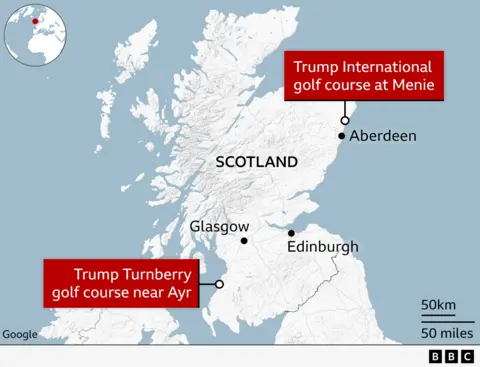In a significant development for international trade relations, the United States and the European Union (EU) have successfully negotiated a new trade agreement that aims to resolve a prolonged impasse between these two economic giants. The deal, finalized after intense discussions between U.S. President Donald Trump and European Commission President Ursula Von der Leyen at Turnberry, Scotland, introduces a 15% tariff on EU exports to the U.S., a move that is deemed a critical step in stabilizing the transatlantic trade landscape.
The new agreement marks the end of a potential trade war, particularly as President Trump had previously threatened to impose a 30% import tax on all EU goods. By cutting this threat in half, the U.S. is expected to open its markets for certain EU products without any tariffs, providing crucial opportunities for both sides. Von der Leyen expressed optimism about the deal, highlighting its potential to foster economic stability and mutual growth, especially in light of the fact that both regions account for nearly one-third of the global trade marketplace.
Discussing the terms of the deal, Trump insisted that his administration has been committed to addressing the significant trade imbalance that has historically favored the EU. In contrast to this, the U.S. imported approximately $606 billion worth of goods from Europe and exported only around $370 billion, which was a cause of concern for the American administration. Additionally, the agreement specifies that certain goods, including aircraft components, specific agricultural products, and various chemicals, will be exempt from tariffs, while the controversial 50% global tariff imposed by the U.S. on steel and aluminum remains in effect.
After the talks, President Trump declared, “We have reached a deal. It’s a good deal for everybody,” emphasizing a strengthened partnership between the two economic regions. Von der Leyen echoed this sentiment, characterizing the outcome as a “huge deal” after what she described as challenging negotiations. This agreement not only serves the interests of both parties but may also encourage further investments; Trump suggested that EU investments in the U.S. could reach $600 billion, significantly boosting American industries and potentially reducing reliance on foreign energy sources.
As the deal reverberates through the European political landscape, leaders expressed mixed responses. The Irish Prime Minister, Micheál Martin, noted that while striving for a more favorable arrangement, higher tariffs would inevitably complicate trade in the region. Similarly, Germany’s Chancellor Friedrich Merz acknowledged the importance of stable ties, stating the need for predictable trade relations that benefit both sides. On a broader scale, Italian Prime Minister Giorgia Meloni welcomed the new terms but indicated that she required a detailed examination of the conditions before forming a conclusive opinion.
Despite its benefits, questions regarding the balance of benefits within the deal remain. European officials have expressed concerns that despite claiming victory, they may not sufficiently capitalize on the concessions offered. Von der Leyen’s remarks about the necessity of “rebalancing” the trading relationship suggest an ongoing awareness of the complexities involved, particularly since previous EU stances maintained that the import-export relationship was already relatively balanced.
The recently established tariffs will undoubtedly reshape aspects of trade flow, but both sides will need to navigate the details with caution. Overall, this agreement represents a turning point in U.S.-EU relations, underscoring the significance of dialogue and negotiation in global trade dynamics. The long-standing implications of this deal could provide new avenues for economic growth, investment, and stability as the two allies turn the page on months of uncertainty in their trading history.












